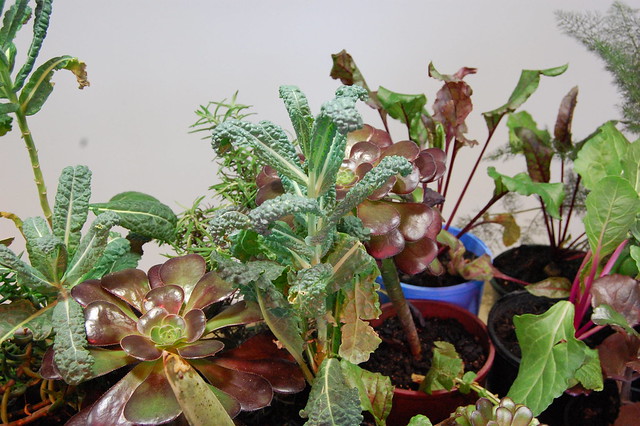
Lauren Berkowitz, detail from Sustenance, late Sept 2010, MCA.
The following is a guest contribution, from Lucy, who works as a Visitor Services Officer (VSO) at the MCA. VSOs work from 10am to 5pm each day, and rotate throughout the museum every half hour. I think they represent a massive untapped resource of information about the way that artworks operate. Artists make the work; curators choose it, place it, write about it; gallery-goers experience it briefly when they visit. But nobody spends as much time with the work as the VSOs.
The MCA tends to employ artists, and sometimes art students, as VSOs. Thus, these gallery invigilators are far from “public servants” who perform a mechanical function of surveillance. Rather, the VSOs, while they are watching to make sure nothing goes awry, and writing reports on mishaps, are also thinking deeply about what is the role of art, and how particular artworks function in practice (rather than in the ideal space of the artist’s studio, or the utopian zone of the exhibition catalogue).
And so it is with Lucy, who has penned this thoughtful response to three artworks which are part of the In the Balance exhibition, each of which use plants in a different way.
Here is her guest blog:

Plants in the balance: a contribution by Lucy Ainsworth.
In the Balance is an exhibition about environmental concerns, so it seems relevant to include artworks containing living plants. Some of the artists using plants in this exhibition are Lauren Berkowitz, Diego Bonetto and Artist As Family.
Being a VSO at the MCA means that I spend copious amounts of hours with the artworks and get to know them from a unique perspective. Over the past weeks I’ve been watching the plant works growing and changing and it got me thinking about them in relation to the Environmental Audit. We all know that plants are good for the environment, but are these particular plant artworks environmentally friendly and sustainable or are they purely conceptual and aesthetic? (Perhaps they offload some of the carbon emissions generated by the other artworks!)
These are some questions/issues I thought were important to think about:
What is the place, purpose and point of having these plant works in the exhibition? How can you have an exhibition about the environment without having plants? Or perhaps how can you have an exhibition about the environment with plants? What additional resources are used/required to display the plant-works? And what happens to the plants after the exhibition finishes?
One of the key factors in terms of how this relates to the Environmental Audit is this: unlike other works, which need minimal attention after they’re installed (this is a generalisation), the plants need regular watering, sunlight, insect inspections and general upkeep. Basically, having a living artwork requires extra resources to look after and maintain it.
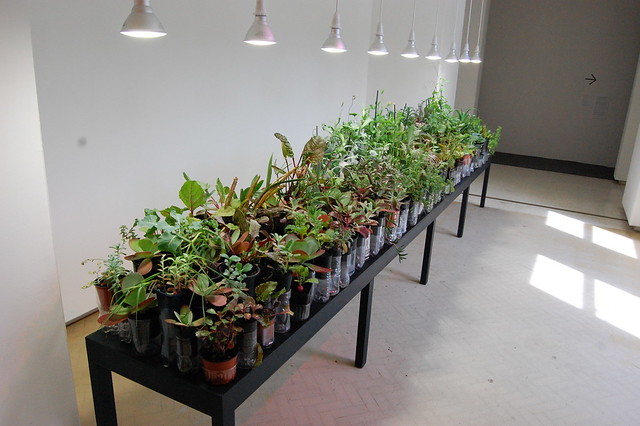
Lauren Berkowitz, Sustenance, installation at the MCA, 2010.
At the beginning of the exhibition I was interested in Lauren Berkowitz’s Sustenance and have been watching it closely over the weeks. I began to notice a rapid change in the condition of the plants, with some starting to look a little ‘sad’ after a week or so. When a visitor approached me very concerned about the state of the plants, she offered to come into the MCA and take care of them free of charge. It got me thinking about the issues of housing plants in a museum that is climate controlled to suit more conventional artworks and not living plants. Although the plants are watered and rotated (with the plants outside on the balcony) regularly, some are still looking in need of a little love. Many of the plants have since died indicating that housing plants in a museum like this is not very sustainable.
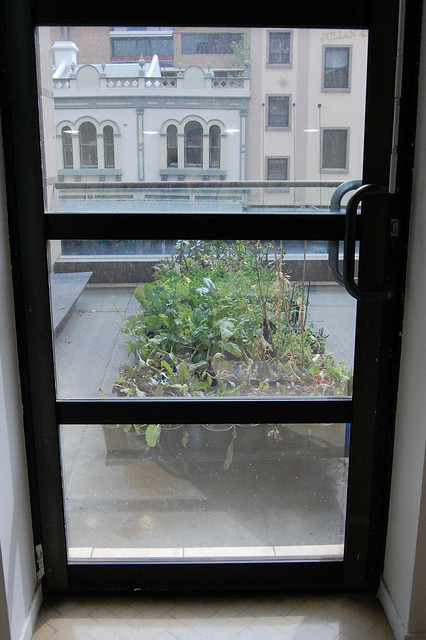
Lauren Berkowitz’s plants on the MCA balcony.
Also, from an “auditing” perspective all the plants are edible and medicinal so serve a practical purpose, which is to be harvested and eaten. However, these plants function as specimens of edible and medicinal plants and have a more conceptual purpose. This raises the question, that because this is an exhibition about the environment should the plant works be functional and practical or is it ok for them to be purely aesthetic and conceptual, hence unsustainable?
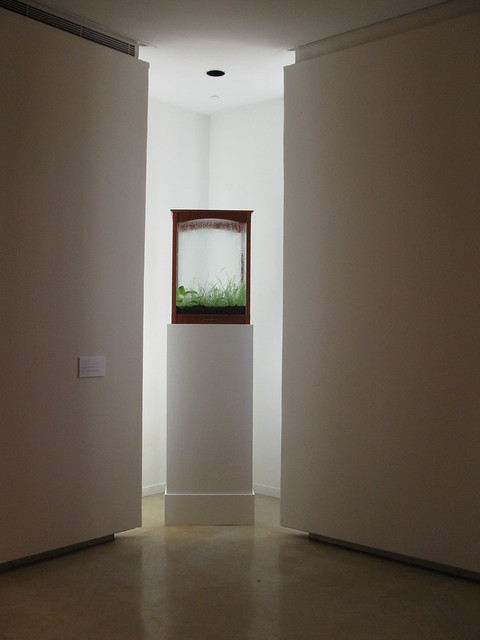
Diego Bonetto, weed-terrarium installed at the MCA, 2010.
Another work that captured my curiosity was Diego Bonetto’s 5 terrariums, 5 tours and a world of Facebook friends, which are located in corners and windows throughout the exhibition. These works are certainly “sustainable”; they practically take care of themselves. The terrariums provide a controlled environment supplying the energy, water, humidity etc the weeds need to grow and be completely self-sufficient. The initial soil sample is placed into the terrarium, the weeds grow, using all the nutrients in the soil, die, fertilising the soil and grow again. Terrariums are what natural museums use to display living plants, so it’s a logical choice.

Diego Bonetto, detail of terrarium showing weeds which have emerged from soil sourced from The Domain, Sydney.
In contrast to Lauren Berkowitz’s Sustenance, Bonetto’s work requires minimum maintenance so is quite sustainable. It is no surprise that weeds are more sustainable and easier to maintain, isn’t that why they are weeds! Perhaps Diego’s work will encourage people to forage and eat edible weeds. This has to be good for the environment!
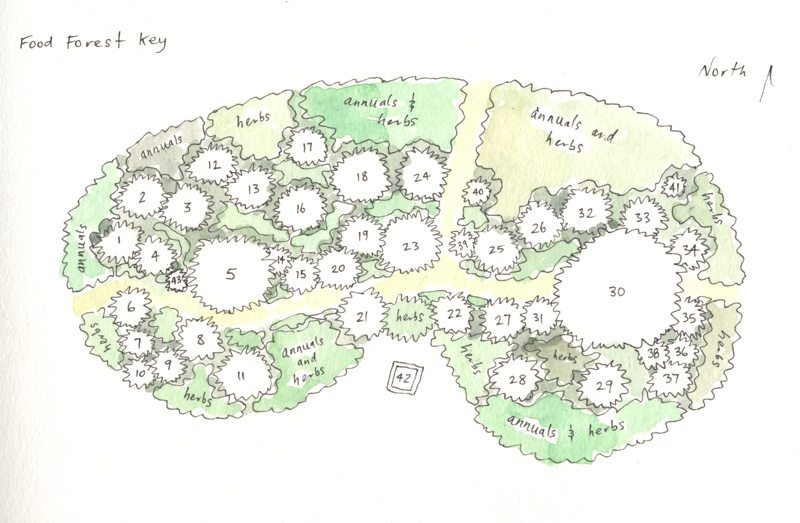
The Artist as Family, Food Forest, Plan Drawing, 2010
Food Forest, by the Artist as Family, is a site-specific community garden in Surry Hills. It operates outside of the museum context, and therefore avoids some of the problems the in-house plant works have. Food Forest is easily compared to Lauren’s Sustenance as it also uses edible plants. Although, instead it has a functionality and environmental purpose, to provide an ongoing food supply to the church’s soup kitchen and encourage participation from the local community.

The Artist as Family, Food Forest, mid-2010, Surry Hills, Sydney.
This work requires constant maintenance to ensure the plants are healthy, with regular water and fertiliser and harvesting when ready and needed. Although the project requires extra resources, in terms of the Environmental Audit it is more sustainable long term. For argument’s sake, just like Lauren Berkowitz’s Sustenance, you could analyse the aesthetic/conceptual vs. the practical/functional aspects of the work. Perhaps Food Forest is more practical and functional?
Overview – All three works have varying levels of required care, maintenance and end results. Sustenance requires constant watering, moving (so they have some time in the sunlight and fresh air), and insect spray to stop the aphids eating them but the plants won’t be harvested. After the initial install, 5 terrariums, 5 tours and a world of Facebook friends requires low maintenance; terrariums are built to be self-sufficient and don’t need to be watered or moved often, but the weeds won’t be harvested. Food Forest requires watering (but it is located outside so will have rain) and fertiliser, and can be harvested for eating.
So is all the care and maintenance for these plants worth-while for the exhibition?
Here’s a diagram:
Finally, Lucas raised this question about the Future Farmers Sunshine Still and Sun Runner – what will happen to the works after the exhibition closes?
Food Forest will remain an ongoing project but what will happen to Lauren’s plants and Diego’s weeds? Maybe we can have an MCA picnic or they can be composted or consumed by a worm farm?


nice post. just a few things…
re the food forest: it is designed to self-fertilize true to a forest ecology. hence the mulch producing deciduous trees. the spontaneous fungi, flora and fauna (mainly birds) also improve and fertilize the soil for new growth – these are autonomous systems that come about through designing a polyculture. (nb: fungi are disassemblers breaking down organic matter and preparing it as food for plants, some weeds fix nitrogen and other nutrients, birds allay insects and leave manure)
human generated activity – bringing yr home compost and exchanging it for food – is less a thing of ‘maintenance’, to use your term, and much more a thing of social-ecological engagement. in this way the forest is autopoetic, where humans are part of this local, self-renewing, biological system.
Good job- great to see some reaction and dedication to Lucas’ project from vso land. Much approve of the picnic idea.. i think it should also incorporate some of the food coming from the food forest, and take place in front of st michael’s church!
PS: In terms of sustainability, are you not only factoring in water but lighting too ? Because according to that i think (as opposed to the terrariums) the food forest would be more environmentally friendly given that it purely uses sunlight, and no artificial gallery lighting(not that the terrariums use much as they’re placed near windows but I do believe they are exposed to subtle lighting- right?).Also, are you factoring in how much impact each work has on audiences and the degree to which each work will catalyse continued public action towards sustainable living as well as education? (By this I mean how do we extract as much from the works as possible and use them as tools for change and awareness?)
Just some ideas, hope they make sense. Good work Lucy!
just another thought into this compost of content and comments:
‘constant maintenance… with regular water…’ is better suited language when describing an applied desert, such as a football oval or the roof of new parliament house in canberra. yes, the food forest, as applied ecology, might die if unwatered by humans over this first summer, but it’s designed to look after itself after a few seasons of sending down deep roots, with some room for more water intensive, shallow rooted human interactivity (ie annual vegetable gardening). so i think your above diagram for the AaF for ‘watering’ should read: Y (short term) & N (long term), and for ‘other upkeep’ should read: after initial setup it is self-sufficient, as human and nonhuman biology participates in its autopoetic sufficiency.
another important point is that although this work can be traced back to the artists who made it, it is not dependent on us for its autonomy. it can’t be capitalised upon, it can’t end up in sotheby’s as it’s ownership is community based. in other words it is a work that actively doesn’t participate in consumption ideology, or private ownership of cultural artifacts. this is one of the clear conceptual elements to the work, and synonymous with ecological systems it provides a model for art beyond growth capital ideology (hoarding resources and creating social hierarchies around them), which, of course, are inherently anti-ecological (or ‘unsustainable’, to use a passive word) as today’s age article attests: http://www.theage.com.au/environment/consumption-outstrips-earths-production-20101013-16k0v.html
Thanks for your comments Patrick. It’s great to hear about some of the specifics of your project, there are so many factors to consider!